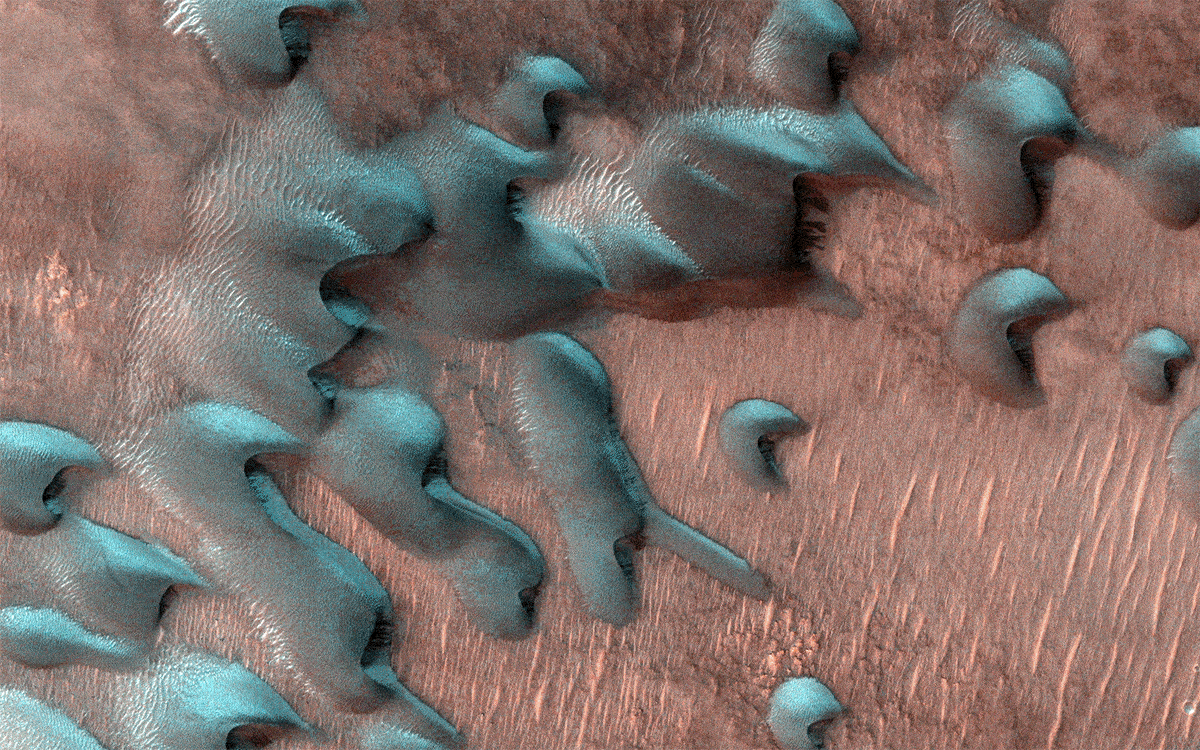De HiRISE-camera aan boord van NASA’s Mars Reconnaissance Orbiter legde deze beelden vast van met ijs bedekte zandduinen net na de winterzonnewende. De rijp hier is een mengsel van kooldioxide (droog) ijs en watersneeuw en zal binnen een paar maanden verdwijnen als de lente aanbreekt. Afbeelding tegoed: NASA/JPL-Caltech/Universiteit van Arizona
Kubusvormige sneeuw, ijzige landschappen en vorst maken allemaal deel uit van het koudste seizoen op de Rode Planeet.
Als de winter komt[{” attribute=””>Mars, the surface is transformed into a truly otherworldly holiday scene. Snow, ice, and frost accompany the season’s sub-zero temperatures. Some of the coldest of these occur at the planet’s poles, where it gets as low as minus 190 degrees Fahrenheit (minus 123 degrees Celsius).
Cold as it is, don’t expect snow drifts worthy of the Rocky Mountains. No region of Mars gets more than a few feet of snow, most of which falls over extremely flat areas. And the Red Planet’s elliptical orbit means it takes many more months for winter to come around: a single Mars year is around two Earth years.
Ook op Mars valt sneeuw, ijs en rijp.[{” attribute=””>NASA’s spacecraft on and orbiting the Red Planet reveal the similarities to and differences from how we experience winter on Earth. Mars scientist Sylvain Piqueux of JPL explains in this video. Credit: NASA/JPL-Caltech
Still, the planet offers unique winter phenomena that scientists have been able to study, thanks to NASA’s robotic Mars explorers. Here are a few of the things they’ve discovered:
Two Kinds of Snow
Martian snow comes in two varieties: water ice and carbon dioxide, or dry ice. Because Martian air is so thin and the temperatures so cold, water-ice snow sublimates, or becomes a gas, before it even touches the ground. Dry-ice snow actually does reach the ground.
“Enough falls that you could snowshoe across it,” said Sylvain Piqueux, a Mars scientist at NASA’s Jet Propulsion Laboratory in Southern California whose research includes a variety of winter phenomena. “If you were looking for skiing, though, you’d have to go into a crater or cliffside, where snow could build up on a sloped surface.”

HiRISE captured these “megadunes,” also called barchans. Carbon dioxide frost and ice have formed over the dunes during the winter; as this starts to sublimate during spring, the darker-colored dune sand is revealed. Credit: NASA/JPL-Caltech/University of Arizona
How We Know It Snows
Snow occurs only at the coldest extremes of Mars: at the poles, under cloud cover, and at night. Cameras on orbiting spacecraft can’t see through those clouds, and surface missions can’t survive in the extreme cold. As a result, no images of falling snow have ever been captured. But scientists know it happens, thanks to a few special science instruments.
NASA’s Mars Reconnaissance Orbiter can peer through cloud cover using its Mars Climate Sounder instrument, which detects light in wavelengths imperceptible to the human eye. That ability has allowed scientists to detect carbon dioxide snow falling to the ground. And in 2008, NASA sent the Phoenix lander within 1,000 miles (about 1,600 kilometers) of Mars’ north pole, where it used a laser instrument to detect water-ice snow falling to the surface.
https://www.youtube.com/watch?v=mjuwZKel-XU
NASA-wetenschappers kunnen de grootte en vorm van de verdeling van sneeuwdeeltjes, laag voor laag, in de storm meten. De Global Precipitation Measurement Mission is een internationaal satellietproject dat elke drie uur de volgende generatie waarnemingen van wereldwijde regen en sneeuw zal leveren. Credits: NASA’s Goddard Space Flight Center/Ryan Fitzgibbons
ijsblokjes
Vanwege de manier waarop watermoleculen aan elkaar worden gebonden wanneer ze bevriezen, hebben sneeuwvlokken op aarde zes zijden. Hetzelfde principe geldt voor alle kristallen: de manier waarop de atomen zich organiseren, bepaalt de vorm van het kristal. In het geval van koolstofdioxide komen de moleculen in droogijs altijd samen als vieren wanneer ze bevroren zijn.
“Omdat kooldioxide-ijs een symmetrie van vier heeft, weten we dat droge sneeuwvlokken kubusvormig zullen zijn”, zei Bicchio. “Dankzij het veiligere klimaat op Mars kunnen we zeggen dat deze sneeuwvlokken kleiner zullen zijn dan de breedte van een mensenhaar.”

De HiRISE-camera legde dit beeld vast van een kraterrand midden in de winter. De vorm van de naar het zuiden gerichte helling van de krater, die minder zonlicht ontvangt, is vlekkerig en helder rijp, weergegeven in blauw in deze afbeelding met verbeterde kleuren. Afbeelding tegoed: NASA/JPL-Caltech/Universiteit van Arizona
Jack Frost knabbelt in je rover
Zowel water als koolstofdioxide kunnen rijp vormen op Mars, en beide soorten rijp komen vaker voor op de planeet dan sneeuw. De Viking-lander zag watervorst toen ze Mars in de jaren zeventig bestudeerden, terwijl NASA’s Odyssey-orbiter zag Er wordt ijsvorming waargenomen en deze sublimeert weg ochtendzon.

HiRISE legde deze lentescène vast, toen in de grond bevroren waterijs de aarde in veelhoeken splitste. Het transparante koolstofdioxide-ijs laat zonlicht door en verwarmt de gassen die door de ventilatieopeningen sijpelen, waardoor waaiers van donker materiaal naar het oppervlak schieten (blauw weergegeven in deze verbeterde kleurenafbeelding). Afbeelding tegoed: NASA/JPL-Caltech/Universiteit van Arizona
Het vreemde einde van de winter
Misschien komt de meest verbazingwekkende ontdekking aan het einde van de winter, wanneer al het gecreëerde ijs begint te “smelten” en in de atmosfeer sublimeert. Terwijl het dit doet, neemt dit ijs vreemde, mooie vormen aan waar het wetenschappers aan deed denken spinnenEn de Dalmatische plekkenEn de Gebakken eierenEn de Zwitserse kaas.
Dit “smelten” zorgt er ook voor dat geisers ontploffen: het doorzichtige ijs laat zonlicht het gas eronder opwarmen, en dat gas explodeert uiteindelijk, waardoor stof fans op het dak. Wetenschappers zijn al begonnen met het bestuderen van deze fans als een manier om meer over hen te weten te komen In welke richting waaien de Marswinden?.

“Bierliefhebber. Toegewijde popcultuurgeleerde. Koffieninja. Boze zombiefan. Organisator.”







More Stories
Een nieuw rapport zegt dat het gebruik van ras en etniciteit soms “schadelijk” is in medisch onderzoek
SpaceX lanceert 23 Starlink-satellieten vanuit Florida (video en foto’s)
NASA zegt dat de “Halloween-komeet” zijn vlucht langs de zon niet heeft overleefd